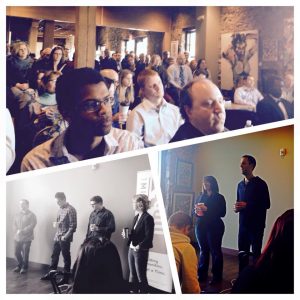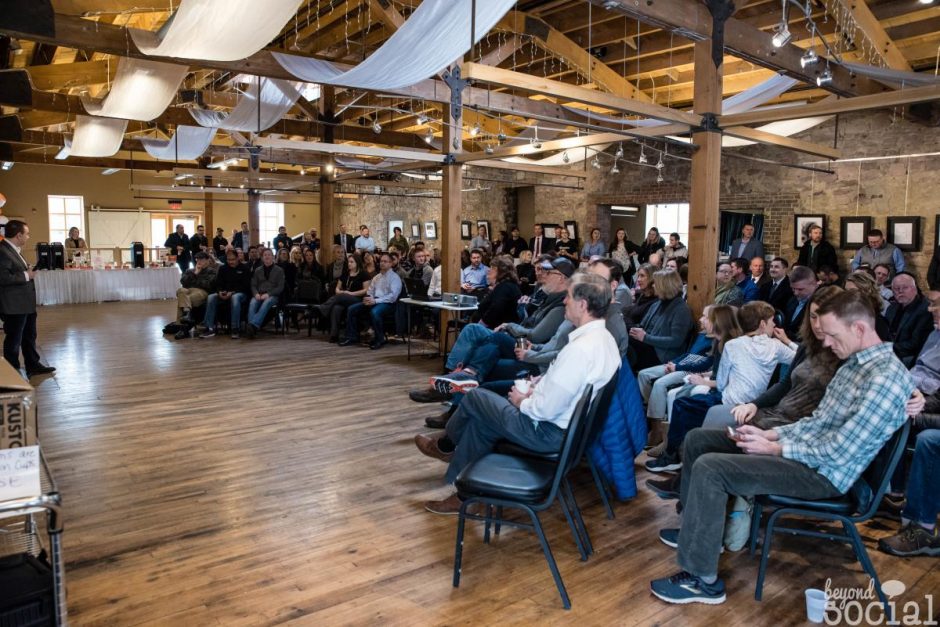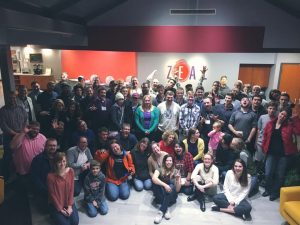
I have been organizing community events for small business owners, startup founders and entrepreneurs for the last five years through a variety of different organizational umbrellas. The first event that I organized entirely on my own accord was a mini-mastermind event on November 26th, 2014 at the Sioux Falls Design Center. Since then, I’ve been helping with the weekly 1 Million Cups event, organized several of my own events and recently helped organize the annual Innovation Expo conference.
People have asked why I put so much volunteer time into putting together events and creating community for entrepreneurs. The simple answer is entrepreneurship is also a very lonely game. For the first several years, a business owner may be working by themselves in a small shop or a home office and may not have many other business owners they can relate to. Hosting community events for small business owners and startup founders is encouraging to them because it lets them know they are not alone and allows them to benefit from the knowledge and wisdom of other business owners. I have been very successful in my own endeavors and hosting events to encourage other entrepreneurs is one way that I try to give back to the community.
Over the last several years, I have learned a variety of best practices for startup community events. Of course, each community is different, and your mileage may vary.
Here are some of the best practices that I follow when organizing startup community events:
#1 – Don’t do the same event more than once per year. If you do an event with the same name and format several times per year, people will feel like they have already gone to the event and will stop coming to it. I think this is one of the reasons why 1 Million Cups has struggled in recent history to get more than 50 people to attend each week, whereas the September Startup Social event had 130 in attendance. People always visit the new restaurant, the new retail store or the new bar. Then, the interest fades off over time. I try to give each event a unique name and a unique format, such as our “Morning Marketing Party” that was last month and the “Startup Horror Stories” event we are doing on Halloween.
#2 – There’s no perfect time of day or day of the week to hold an event. No matter what time of day you hold a startup community event, someone will complain that time doesn’t work for them. Everyone has different schedules and commitments. Some people have day jobs, and some don’t. Some people have children, and some don’t. Some people prefer evening events and some people prefer morning events. Some people would prefer weekend events and other people want events embedded into the workday. The only way to address this issue that I have found is to switch up when and where you do events. For Startup Sioux Falls, we will do a mix of morning events, lunch and learns and 4:00 PM happy hour events and will get a slightly different crowd at each. We also move these events around between the Zeal Center and various locations downtown.

#3 – Use Eventbrite to track your RSVPs.– We use Eventbrite for registrations for Startup Sioux Falls events because it’s a slightly higher barrier to entry than clicking “attending” on Facebook, meaning that people who say they are going to attend are more likely to attend. Eventbrite provides the email addresses of all the registrants for your event, so you can add them to your mailing list after the fact. Finally, Eventbrite allows attendees to make a donation so that your superfans can voluntarily contribute to the cost of your event.
#4 – 50% of RSVPs for a free event will show up. Not much to say here, but people get busy and their plans change. It’s generally a safe bet to plan that 50%-60% of the people that RSVP for a free event will actually show up. Even for paid events, the show-up rate for an RSVP may be around 75%-80%. This rule of thumb is especially handy for food and beverage orders so that you don’t end up with way too much food at the end of the event.
#5 – Always have a theme to your events. If you put on a general business networking event, you may have trouble collecting sign-ups for your event. There are all sorts of referral groups, such as BNI, that exist in the city and anyone that wants to be part of one is probably already part of one. Instead, we try to give each event some sort of theme and unique structure. For example, at our Morning Marketing Party, we stood in a giant circle and had each person share a marketing tip that’s worked for them. I find that events with a format and structure feel a bit safer for first-time attendees that may be intimidated by going to a chamber mixer or another unstructured networking event.
#6 – Use your social media channels, repeatedly. When we do an event for Startup Sioux Falls (SSF), we will share them to the SSF Facebook Group, SSF Facebook Page, SSF LinkedIn Profile, SSF Twitter Account, my personal social media profiles and usually all of Maureen’s as well. We typically try to share an event at least 5 times in the three weeks leading up to the event. Attention on social media is fickle and you really need to promote the event repeatedly to get the RSVPs you are hoping for. We will also use the Startup Sioux Falls and Zeal email lists to invite people that have participated in past events to sign-up for our next event.

#7 – Traditional event promotion methods still work. While it may seem that the world has moved entirely to Facebook and Instagram, some of the event promotion techniques that worked ten years ago still work well today. Most cities have community event calendars where you can post your event for free. Meetup.com works well as a promotion tool in some cities. We have had good luck getting local media outlets including the Argus Leader, Keloland and KDLT to promote our events. We have even tried mailing physical postcards to invite people to events. While your primary marketing tools may be social media and email, don’t ignore the other promotional techniques that are available to you.
#8 – Bring food. Everybody likes food. Coffee, donuts, and fruit work well for morning events. For noon lunch and learns, be prepared to provide lunch or have lunch available for purchase at your venue. For 4:00 PM events, appetizers and beer and wine are usually offered.
#9 – Leverage cohosts. If you can run your event in collaboration with another group, it will reduce your workload and get more people to attend your event. Startup Sioux Falls and Zeal have organized several events together, which has allowed us to share costs, split the workload and get more people to show up to our joint events. It’s been such a good partnership that we are planning on merging at the end of the year.
#10 – Lineup volunteers ahead of time. Try to have one or two volunteers stand near the door and greet people as they come to your event. People attending for the first time may feel unsure of themselves a friendly smile and a handshake can ease a lot of first-time attendee nervousness. Get a photographer to take photos of your event so that you are not trying to take photos while running the event ahead of time. Make sure that someone at the event is in charge of food and drinks as well. Don’t try to do everything yourself. Utilize your friends and family to help you run your startup community event.

#11 – Don’t wing it. I don’t believe that you need a full script for each of your events, but at least have a set of bullet points for all of the items that you want to cover during your event so that you don’t forget anything important. We typically start off with the event hosts introducing their organizations and the format of the event. We then have attendees introduce themselves and share a bit about themselves and their job or businesses. We’ll then have the speaker or the primary event activity happen. At the end, we will gather everyone together and share some highlights from the event, thank our sponsors and remind people about other events that are coming up.
#12 – If more than 25 people are coming, bring a microphone. When you have a bigger crowd, people just don’t speak loud enough for everyone else in the room to hear them. Borrow a microphone and speaker so that everyone can hear everyone else when they share.
#13 – Meet people where they are at. At our morning marketing party, someone asked if they should attend the event because they haven’t launched a business yet and don’t have a marketing tip to share. That honest question genuinely made me feel bad because I have always tried to be very inclusive with my events because I want to encourage people regardless of where they are at in their entrepreneurial journeys. When writing the descriptions for your events, try to use inclusive language that makes people feel welcome regardless of what stage their business is in. We will also often use the phrase “small business owners, startup founders and entrepreneurs” in our event invites because some people see themselves as small business owners but not as entrepreneurs or startup founders.
My final piece of advice is to make your own best practices list. What works well in my community may not work well for your community. After you do an event, take time to write down what you thought went well and what didn’t. That way you are able to build upon the lessons from your past events and can continue to improve your event game.
